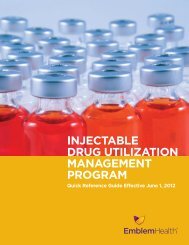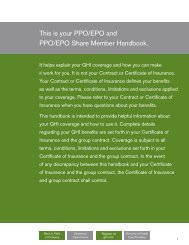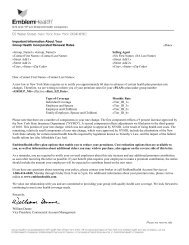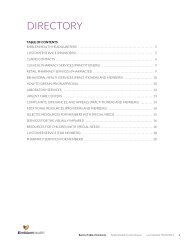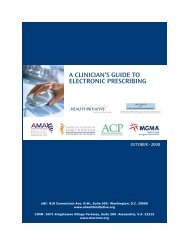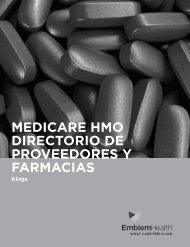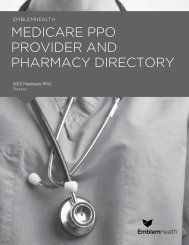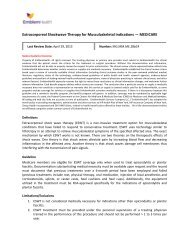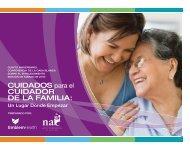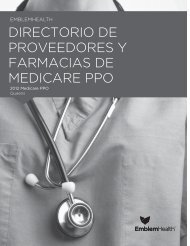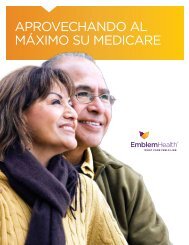PPO II - EmblemHealth
PPO II - EmblemHealth
PPO II - EmblemHealth
Create successful ePaper yourself
Turn your PDF publications into a flip-book with our unique Google optimized e-Paper software.
2013 Evidence of Coverage for <strong>PPO</strong> <strong>II</strong><br />
Chapter 12: Defi nitions of important words<br />
Chapter 12: Defi nitions of important words<br />
209<br />
Ambulatory Surgical Center – An Ambulatory Surgical Center is an entity that operates exclusively for<br />
the purpose of furnishing outpatient surgical services to patients not requiring hospitalization and whose<br />
expected stay in the center does not exceed 24 hours.<br />
Annual Enrollment Period – A set time each fall when members can change their health or drugs plans<br />
or switch to Original Medicare. Th e Annual Enrollment Period is from October 15 until December 7.<br />
Appeal – An appeal is something you do if you disagree with our decision to deny a request for coverage<br />
of health care services or prescription drugs or payment for services or drugs you already received. You<br />
may also make an appeal if you disagree with our decision to stop services that you are receiving. For<br />
example, you may ask for an appeal if we don’t pay for a drug, item, or service you think you should be<br />
able to receive. Chapter 9 explains appeals, including the process involved in making an appeal.<br />
Balance Billing – A situation in which a provider (such as a doctor or hospital) bills a patient more than<br />
the plan’s cost-sharing amount for services. As a member of our plan, you only have to pay the plan’s<br />
cost-sharing amounts when you get services covered by our plan. We do not allow providers to “balance<br />
bill” you. See Chapter 4, Section 1.3 for more information about balance billing.<br />
Benefi t Period –Th e way that both our plan and Original Medicare measures your use of hospital and<br />
skilled nursing facility (SNF) services. For Skilled Nursing Facility stays, a benefi t period begins the<br />
day you are admitted as an inpatient in a SNF. Th e benefi t period ends when you haven’t received any<br />
inpatient hospital care or skilled care in a SNF for 60 days in a row. If you go into a skilled nursing<br />
facility after one benefi t period has ended, a new benefi t period begins. For inpatient hospital stays, a<br />
benefi t period begins when you are admitted to the hospital and ends when you are discharged from<br />
the hospital. If you are admitted to the hospital after one benefi t period has ended, a new benefi t period<br />
begins. Th ere is no limit to the number of benefi t periods.<br />
Brand Name Drug – A prescription drug that is manufactured and sold by the pharmaceutical company<br />
that originally researched and developed the drug. Brand name drugs have the same active-ingredient<br />
formula as the generic version of the drug. However, generic drugs are manufactured and sold by other drug<br />
manufacturers and are generally not available until after the patent on the brand name drug has expired.<br />
Catastrophic Coverage Stage – Th e stage in the Part D Drug Benefi t where you pay a low copayment<br />
or coinsurance for your drugs after you or other qualifi ed parties on your behalf have spent $4,750 in<br />
covered drugs during the covered year.<br />
Centers for Medicare & Medicaid Services (CMS) – Th e Federal agency that administers Medicare.<br />
Chapter 2 explains how to contact CMS.<br />
Coinsurance – An amount you may be required to pay as your share of the cost for services or<br />
prescription drugs. Coinsurance is usually a percentage (for example, 20%).<br />
Combined Maximum Out-of-Pocket Amount – Th is is the most you will pay in a year for all Part A and<br />
Part B services from both network (preferred) providers and out-of-network (non-preferred) providers. See<br />
Chapter 4, Section 1 for information about your combined maximum out-of-pocket amount.<br />
Comprehensive Outpatient Rehabilitation Facility (CORF) – A facility that mainly provides<br />
rehabilitation services after an illness or injury, and provides a variety of services including physical<br />
therapy, social or psychological services, respiratory therapy, occupational therapy and speech-language<br />
pathology services, and home environment evaluation services.



